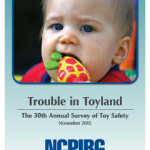
Trouble in Toyland 2015
The 30th Annual Survey of Toy Safety
Downloads
NCPIRG Education Fund

For 30 years, NC PIRG Education Fund has conducted an annual survey of toy safety, which has led to over 150 recalls and other regulatory actions over the years, and has helped educate the public and policymakers on the need for continued action to protect the health and wellbeing of children.
Among the toys surveyed this year, we found potential choking and noise hazards, one toy that exceeded federal toxic standards, and three toys that preliminary testing showed may exceed federal standards. This report not only lists the potentially dangerous toys that we found this year, but also describes why and how the toys could harm children.
The continued presence of hazards in toys highlights the need for constant vigilance on the part of government agencies and the public to ensure that children are not harmed by unsafe toys.
Standards for toy safety are enforced by the Consumer Product Safety Commission (CPSC). Safety standards include limits on toxic substances in children’s products, size requirements for toys for small children, warning labels about choking hazards, measures to keep magnets and batteries inaccessible, and noise limits.
NC PIRG Ed Fund staff examined hundreds of toys to confirm that they are safe. We discovered that unsafe toys remain widely available. The problems we found include:
- Phthalates. Exposure to phthalates at crucial stages of development may harm development of the male reproductive system, and is linked to early puberty. Lab tests confirmed that a jump rope purchased by our shoppers contained phthalates at levels greater than the legal limit.
- Chromium. Skin contact with chromium can cause severe allergic reactions including skin redness, swelling, and ulcers. Chromium compounds are also known to cause cancer. This year, preliminary testing revealed 3 toys that may contain unsafe levels of chromium: Minions pencil case, Slinky Jr., and magnetic numbers, and we call on the CPSC to do further testing on these toys.
- Small parts are pieces that might block a child’s airway. Children, especially those under age three, can choke on small parts. Our shoppers identified several toys that contain or may break into small parts, but either do not have the correct U.S. statutory warning label, or any warning label at all. These included a fairy wand, toy car and plane, a Dory figurine, a mini vortex football, and a toy mermaid.
- Small balls less than 1.75 inches in diameter represent a choking hazard for children three years and younger. We found Magic Towels packaged as a small baseball and a small football at Dollar Tree which did not have the appropriate small ball warning label. We also remain concerned about other small, rounded toys, such as toy food, that present the same choke hazard as small balls, but are not labeled as a hazard.
- Balloons are easily inhaled in attempts to inflate them and can become stuck in children’s throats. Balloons are responsible for more choking deaths among children than any other toy or children’s product. We found three balloon sets on store shelves marketed to children under eight.
- Magnets. When two or more powerful magnets are swallowed, they can have fatal health consequences as their attractive forces draw them together inside the body, perforating intestinal walls. We found ellipsoid magnets that are just larger than the small parts cylinder. While we believe these magnets do not technically violate any standards, we include them because their near-small parts size is a concern. We also note that following aggressive enforcement of an all-out ban by the CPSC, small powerful magnets that do fit in the choke test cylinder are nearly impossible to purchase, although we did find one foreign Internet site that still sells them.
- Excessive Noise. Excessive noise exposure can lead to hearing loss. This is especially problematic for young children, because hearing loss at an early age has ramifications for speech development. Our shoppers found five toys marketed to children under three years that are estimated to be either at or slightly above the decibel standards recommended for close-to-the-ear toys which included a toy animal, car, flashlight, magnetic letter set, and a remote.
- Lead. Even low levels of lead in blood have been shown to undermine IQ, attentiveness, and academic achievement. While our shoppers did not find any toys with high levels of lead, the CPSC has recalled toys due to lead limit violations this year.
Despite recent progress in making toys safer, the findings of our 2015 investigation, as well as recent recalls and legal actions against importers, highlight the need for continued attention to shortcomings in existing standards, and vigilance on the part of the shopping public. To keep children safe from potentially hazardous toys, there is still more to do.
Policymakers should continue building upon recent progress in the strengthening of toy safety standards. The CPSC should:
- Continue to vigorously enforce the Consumer Product Safety Improvement Act’s mandatory standards for toys, including strict limits on lead and lead paint in any toys, jewelry, or other articles for children under 12 years;
- Vigorously enforce the Consumer Product Safety Improvement Act’s permanent ban on the use of three specific phthalates in all toys and children’s products;
- Upgrade the interim ban on three additional phthalates into a permanent prohibition and expand it to include additional phthalates;
- Enlarge the small parts test tube to be more protective of children under three;
- Change the small-ball rule to include small round or semi-round objects, and not just “balls” in the strictest definition, since these toys pose the same hazards as small balls, especially rounded toy food, since they are “intended” to be eaten;
- Continue to enforce the use of the United States’ statutory choke hazard warning label;
- Continue to enforce CPSC rules requiring online warning labels; and
- Fully enforce sound and battery standards.
Parents can also take steps to protect children from potential hazards. We recommend that parents:
- Shop with NC PIRG Ed Fund’s Toy Safety Tips, available at toysafetytips.org;
- Examine toys carefully for hazards before purchase – and don’t trust that they are safe just because they are on a store shelf;
- Report unsafe toys or toy-related injuries to the CPSC at www.saferproducts.gov.
- Subscribe to government announcements of recalled products at www.recalls.gov; and
- Remember, toys on our list are presented as examples only. Other hazards may exist.
For toys you already own:
- Remove small batteries if there is any question over their security or inaccessibility and keep them out of reach of children;
- Remove batteries from, or tape over, the speakers of toys you already own that are too loud; and
- Put small parts, or toys broken into small parts, out of reach. Regularly check that toys appropriate for your older children are not left within reach of children who still put things in their mouths.
Topics
Find Out More


Safe At Home in 2024?

5 steps you can take to protect your privacy now
